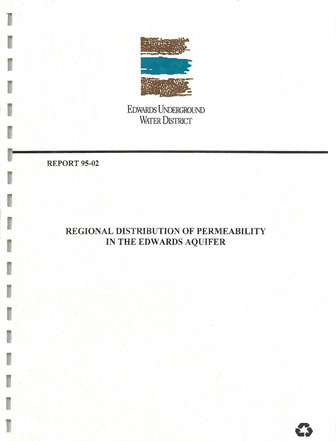Regional Distribution of Permeability in the Edwards Aquifer

| Author | Hovorka SD, Mace RE, Collins EW and Dutton AR assisted by Boghlci EM, Johns ND, Liao J and Baghai NL (University of Texas Bureau of Economic Geology) |
| Year | 1995 |
| Description | Quantitative distribution of various factors controlling permeability and analysis of geographic and geologic relationships in the Edwards aquifer. Note: Large-format versions of the plates for this report are available in a companion document. |
| Report Number | 95-02 |
| Publisher | Edwards Underground Water District |
| Location | Edwards Aquifer |
| Cover | View Download |
| File | View Download |
| Summary |
|
Note: Large-format versions of the plates for this report are available in a companion document. The Edwards aquifer of South Texas is a dual-porosity/dual-permeability system. To describe the permeability structure of the aquifer quantitatively, the distribution of various factors controlling permeability was quantified, and geographic and geologic relationships were analyzed. The major contributors to permeability are (1) structurally controlled fractures and faults, (2) highly porous carbonate matrix, and (3) vertically and horizontally extensive cave systems. Structural mapping of the Edwards Formation in outcrop and in the subsurface was used to define the location and amount of offset along faults and to define areas of potentially higher fracture intensity. Composite displacements of 1,400 to 1,850 ft (430 to 560 m) across the aquifer occur along a series of en echelon normal faults with throws of 100 to 850 ft (30 to 260 m). The areas between the en echelon faults, known as relay ramps, create and maintain the connection of the aquifer unit through faulted regions. Smaller faults and smaller relay ramps within the large fault-bounded blocks impact the permeability distribution primarily because of associated fractures. Specific capacity test results from throughout the aquifer were used to calculate transmissivity using a relationship between specific capacity and transmissivity developed for the Edwards aquifer. Transmissivities vary eight orders of magnitude from 0.1 to 10,000,000 ft2/day (0.01 to 1,000,000 m2/day). Statistical analysis shows that transmissivity systematically varies In different areas of the aquifer but that variability within any area Is high, reflecting the heterogeneous contribution of fractures, matrix, and karst to transmissivity. The distribution of caves and their relationship to stratigraphy and structure was examined using photomosaics of outcrops. Karst processes enlarge fractures by solution and increase their aperture and roughness. Preferential dissolution of dolomitic tidal flat and dolomitized subtidal facies creates stratigraphically controlled conduits and high, touching-vug permeability. Intense diagenesis of the Edwards rocks is the principle control on the relationships between porosity and matrix permeability. Matrix porosity-permeability transforms were developed for (1) particle-dominated aquifer units, (2) the fine-grained Salmon Peak Formation, (3) particle-dominated units In outcrop, and (4) the saline portion of the Edwards, south and east of the aquifer. |
Search for Documents
Advance Search
Explore EAA's Scientific Reports
- All Reports
- Water Use and Conservation
- Geochemistry
- Water Resources Planning and Management
- Floods and Drought
- Water Quality
- Climatology
- Surface Water / Groundwater Relationship
- Biology
- Springs, Groundwater Discharge
- Archaeology
- RZ Protection
- Aquifer Levels
- Remote Sensing
- Precipitation
- Overview Studies
- Modeling
- Hydrology and Hydrogeology
- History
- Groundwater Recharge, Recharge Zone
- Groundwater Movement
- Geomorphology and Caves
- Weather Modification
- Geology
